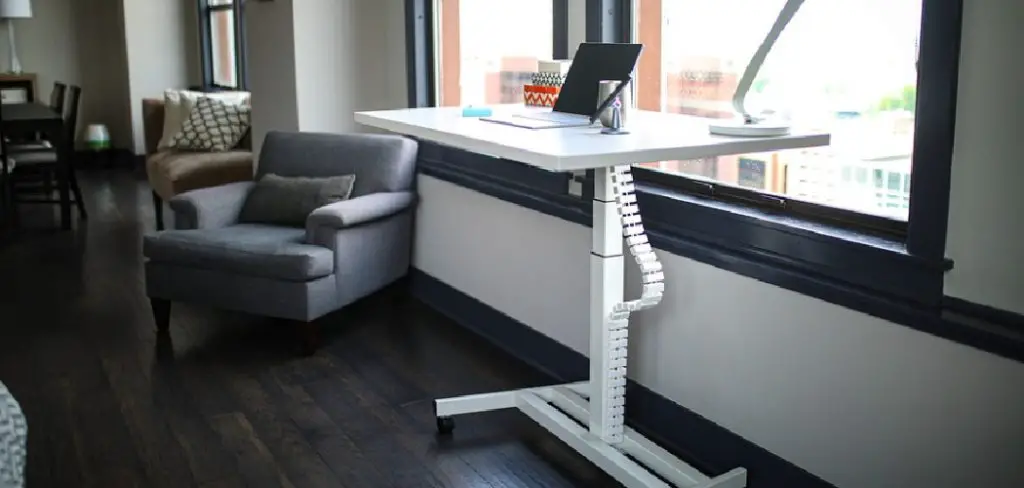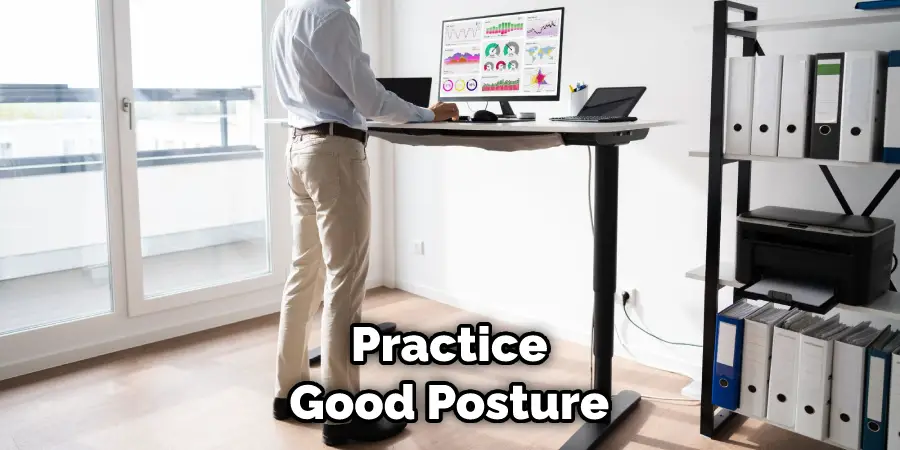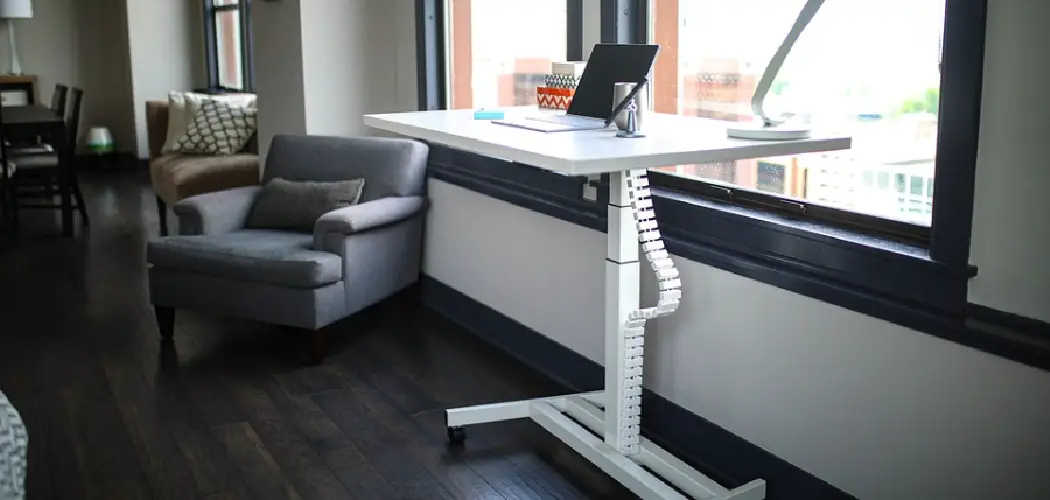Choosing a standing desk is important, as it can significantly impact your health and productivity. A standing desk allows you to change the height of your workstation so that you can alternate between sitting and standing throughout the day.

By giving yourself the option to stand, you will be able to move around more frequently and reduce the risk of developing health conditions related to long periods of sitting.
Standing desks offer a variety of health benefits, such as improved posture, better blood circulation, and greater overall energy. When it comes to choosing the right standing desk for you, there are several factors to consider.
The size and shape of the desk are important, as they will determine how much space you have to work. Consider your available floor space and any special needs related to ergonomics when choosing a standing desk. In this blog post, You will learn in detail how to choose a standing desk.
Importance of How to Choose a Standing Desk
- Comfort: Consider how comfortable your standing desk setup will be by looking at the materials used, size, and shape of the desk, as well as adjustable ergonomic features like a keyboard tray, monitor arms, and footrests.
- Adjustability: Look for a desk that can easily adjust between sitting and standing heights to accommodate different people and tasks. Electric options are available for adjustable desks that easily transition at the push of a button.
- Quality: Look for good quality materials like metal or wood, along with robust construction to ensure your desk can handle the wear and tear of everyday use.
- Surface area: Make sure to consider how much surface area you need and if your desk can accommodate it.
- Budget: Figure out how much you’re willing to spend on a standing desk, and make sure to look for cost-effective models that provide good value for money.
- Space: Consider the size of the space in which you plan to set up your standing desk.
- Design: Select a desk that has an aesthetically pleasing design that fits the overall theme of your office space or home workspace. Consider which colors, shapes, and materials will best suit the look you’re trying to achieve.
Ultimately, how to choose a standing desk depends on your individual needs and preferences. Be sure to consider the key factors discussed above before making your purchase.

Step-by-step Instructions for How to Choose a Standing Desk
Step 1: Inspect the Height of Your Desk
Measure the height of your desk to make sure that it is tall enough for you. If it’s too low, adjust or find a different standing desk that fits your needs better. Think about how often you plan on using the standing desk and why.
Step 2: Consider Your Budget
When shopping around for a standing desk, consider how much you are willing to spend on one. Standing desks can range from very affordable to quite expensive, depending on the features and size. Standing desks come in different varieties, including adjustable-height desks, standing workstations, electric height-adjustable desks, and fixed-height desks. Consider your needs and pick one that best suits you.
Step 3: Decide on Materials
Standing desks are made from a variety of materials, including wood, metal, glass, and plastic. Choose the material that best fits your needs and budget. Think about how much space you have for your standing desk and what size would be most comfortable for you. Measure the space to make sure that your desk will fit.
Step 4: Research Different Brands
Look up reviews on different standing desks and see what people are saying about them. This can help you better understand which brands offer good quality products. Many standing desks come with additional features, such as drawer organizers, monitor arms, and built-in cable management. Consider which ones would be most beneficial for you.
Step 5: Try Out Different Desks
If possible, try out different types of standing desks to understand better how they work. This will help you make sure that the desk is comfortable before investing in it. Once you have done your research and found the perfect standing desk, make your purchase.

Tips for How to Choose a Standing Desk
- Look for features designed to provide optimal comfort and support, such as adjustable heights, monitor arms, anti-fatigue mats, etc.
- Many standing desks have a maximum weight capacity listed in their product descriptions. It is important to make sure you do not exceed this amount when setting up your desk.
- The adjustment range should fit your body size and allow you to maintain a comfortable working posture throughout the day.
- If using multiple monitors, make sure they are set up properly to avoid neck and back strain.
- If possible, choose a standing desk with a built-in footrest or adjustable feet to allow you to keep your legs comfortably in line with the rest of your body while working.
- Your standing desk should have the correct height adjustment to allow you to stand upright with your arms at the correct level.
- These desks provide the option to alternate between sitting and standing throughout the day, which can help reduce fatigue and neck/back pain.
- An ergonomic office chair is essential to maintain good posture while sitting. It should be adjustable and have good lumbar support.
Following these tips when selecting a standing desk will help ensure that you are set up properly for optimal comfort and productivity.
How Much Space Do You Have Available to Accommodate a Standing Desk?
The first thing to consider when selecting a standing desk is how much space you have available to accommodate it. Standing desks come in all shapes and sizes, so you’ll want to measure the area where you plan on putting it and make sure there’s enough room for the size of desk that you’re considering.
If your workspace is limited, look for a model that has adjustable height settings and a minimal footprint. Also, keep in mind any cords or outlets you may need to access while using the desk.
Also, consider how many people are sharing the space and if there is potential for more users in the future. If multiple people use the same workspace, look for desks offering alternate positions for each user.
Some desks even have add-ons, such as monitor arms or keyboard trays, which can help to maximize space and make it easier for multiple people to use the desk comfortably.
Finally, consider a wall-mounted standing desk option if you’re limited on floor space. Wall-mounted desks take up less space while still providing the same health benefits as a full-size standing desk.

What is the Maximum and Minimum Height Range of the Desk?
It is important to consider the height range of the standing desk before making your purchase. Most adjustable standing desks range between 25-50 inches, allowing users of different heights to use the desk comfortably.
Make sure you measure your height and factor it in when selecting a standing desk so that you can adjust it to match your requirements without putting strain on your body.
You should also consider the height range of any chairs you may use with the desk to ensure that it remains comfortable for extended periods of time. Another important factor to consider is the load capacity of the standing desk. Different desks can hold different weights, so read through the product specifications before purchasing.
This will ensure that your desk can handle all of your equipment as well as any stress you may put on it when adjusting the height. Standing desks are designed to be adjustable and should be able to accommodate most users, but it’s always best to double-check just in case.
Finally, make sure you consider the type of material used for construction and the warranty associated with the standing desk. Many desks are made from high-grade materials designed to last for many years, but cheaper models are also available.
Does the Standing Desk Come With a Warranty?

When choosing a standing desk, you should consider whether the desk comes with a warranty. Most desks come with a manufacturer’s warranty, which covers any manufacturing defects or repairs needed due to the normal use of the product. It’s important to read through the warranty details before making your purchase to ensure that it will cover any problems that might arise.
Additionally, you may want to consider purchasing an extended warranty to ensure that you’re covered in the event of any unexpected issues with your desk. This can be especially beneficial if you plan on using your standing desk for many years. Make sure to ask about warranties when comparing different models and brands so that you can make the most informed decision possible.
Are There Height Memory Settings That Are Pre-programmed?
One of the most important things to look out for when choosing a standing desk is whether it has pre-programmed height memory settings. Height memory settings allow you to quickly adjust your desk to the desired height with the press of a button, saving you time and energy.
Consider how often you plan to switch between sitting and standing, and if you find yourself adjusting your desk multiple times a day, then it is definitely worth looking for a desk with height memory settings.
Aside from pre-programmed options, many standing desks also allow you to manually adjust the settings using a digital or manual control system.
Manual control systems are generally more affordable, but digital control systems offer more precise settings and can be easier to use. Choose the control system that best suits your needs, but keep in mind that manual control systems may require more effort when changing the desk height.
No matter which kind of standing desk you choose, make a solution for meets your ergonomic requirements so that you feel comfortable and supported during long stretches of standing.

Is the Standing Desk Easy to Assemble and Adjust?
When deciding on a standing desk, it’s important to consider how easy it is to assemble and adjust. A standing desk that requires complicated assembly or can’t easily be adjusted may not be the best choice for those who want a convenient and comfortable way to work.
Many desks come with adjustable legs, allowing you to customize the height of your desk to your preference. Additionally, some desks have an electric lift system that allows you to raise or lower the desk with the press of a button.
This type of standing desk is the most convenient and can help save time and energy when you want to switch between sitting and standing positions. If you plan on using your standing desk in multiple locations or transporting it frequently, look for a desk with easy disassembly and reassembly.
This way, you’ll be able to set up your desk quickly and easily wherever you go. Remember to consider how easy it is to assemble and adjust your standing desk before making a final decision. The right standing desk should provide comfort and convenience during your work day.
Conclusion
The biggest disadvantage of standing desks is the cost. Standing desks are usually more expensive than regular office furniture, as they require special materials and assembly for height adjustments.
Additionally, some people may experience discomfort or fatigue when using a standing desk if not used properly. It is important to practice good posture when using a standing desk in order to reduce strain on the body.

In conclusion, choosing a standing desk can be difficult, but it is also important to improve your posture and overall health. It is best to consider the size and shape of your workspace, how much you plan on using the desk, and your budget before investing in one.
I hope this article has been beneficial in learning how to choose a standing desk. Make Sure the precautionary measures are followed chronologically.
Check it Out Fix a Wobbly Computer Desk

